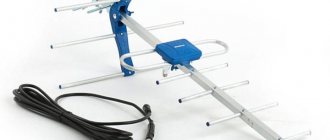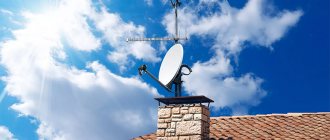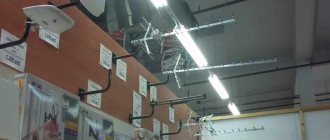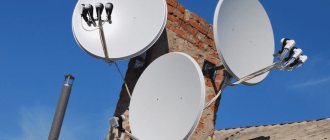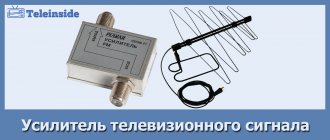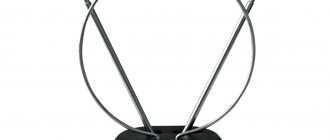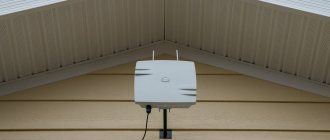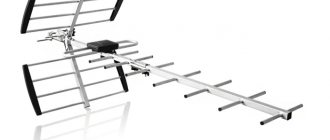Any FORUMHOUSE user knows: country life never lets you get bored even without television. All the time you need to build something, improve it, remove weeds, plow the plot with a motor cultivator, but in the evening you want to take a break from the labors of the righteous. And nothing could be better than getting together with friends on the terrace and watching a football match with your favorite team on TV. Therefore, together with the users of our portal, let’s find out which antenna to install at the dacha so that the signals are received well and the price is reasonable.
Which antenna is better for a summer residence?
Every test of antennas for a dacha shows that the best antenna for a dacha, especially one located 100-120 km from the city, is satellite. It is a leader in the antenna rating because it can provide good reception and a large number of channels. But sometimes, due to the reluctance to put an expensive dish in the garden or the presence of only an old TV that does not handle digital TV well, a very ordinary TV antenna is installed in the dacha. A good old decimeter antenna for a dacha for receiving terrestrial television costs very little, although it does not “catch” many channels.
Hipnose:
– Help me decide which TV antenna to choose for a dacha located 100-120 km from Moscow. I wish she would take channels 5-6. Now it only shows 1 channel, and even that is bad. I want to do without satellite TV. Is there such a possibility?
Opinion of our user with the nickname Alexander 2:
– If the TV tower is about 100-120 km, and in general, more than 50-60 km, then you can forget about on-air reception (it still greatly depends on the terrain). Such a TV antenna will not reach a hundred kilometers from Moscow; you will be able to receive a signal from one of the regional repeaters located in the nearest regional centers.
Before installation, the TV antenna for the dacha is completely disassembled to protect the structural elements from adverse weather conditions, all contacts, threads, nuts and screws are coated with Movil or lithol - in this case, the TV will last not a year, but much longer, you can safely install the mast on the street.
Usually built-in amplifiers work until the first good thunderstorm. And grounding or a lightning rod does not help here. Because Grounding protects the house.
Alexander 2:
– I don’t ground unless the customer categorically insists on it. If the grounded antenna is at a dominant height, then lightning will definitely strike it, and if it is not grounded, then lightning will strike a tall tree in the garden nearby.
Pros and cons of the proposal
Connecting Tricolor to the Internet without a dish is convenient from a variety of points of view. However, in addition to the obvious advantages, this service has some disadvantages. Among the positive features it is worth noting:
- free viewing of channels not available in regular regional packages;
- the ability to connect the receiver anywhere, without being tied to a region;
- no dependence on weather or satellite reception characteristics;
- full functionality of digital television, archive of programs, rewind, pause and other interactive features.
But for some users, the shortcomings of Internet broadcasting technology can create problems.
- You cannot watch Tricolor without a dish using receivers of old models. It is necessary to change the equipment to modern ones.
- In many regions, it is not possible to provide sufficiently high bandwidth and stability of the Internet connection to play video without failures.
It is worth noting that the disadvantages of the service are gradually disappearing with the growth of technical equipment and the level of digital infrastructure of cities, villages, and regions. Therefore, we should expect an increase in demand for watching Tricolor without a dish.
Antenna for a summer residence with an amplifier - which one to choose
Devices for receiving analog television channels with a built-in amplifier can fail during any thunderstorm due to induced electricity - the first stage of the LNA located directly in the antenna breaks through.
Therefore, it is better to use a passive TV antenna, and allocate a place for the amplifier (separate) in a remote location in the country attic - then it will be possible to make adjustments, and you will not have to climb onto the roof after every thunderstorm to change it. The best antenna for a summer residence is aluminum, it is less corrosive, less weight, and as a result, easier to install
The best antenna for a summer residence with an amplifier is passive. The amplifier should be located separately in the attic.
ek73
- Because the amplifier is located at the bottom, there is no power going to the antenna, which means there is less chance of it failing.
It is better to choose an amplifier with separate adjustments for the MV and UHF ranges. The installation height of the antenna and its maximum distance from the roof iron and lighting wires are of decisive importance.
Features of setting up channels without a dish
If Tricolor without a dish connects automatically, all that remains is to select the broadcast source. On the channel there is a corresponding tab in the context menu - you must select “Internet”. When you select a broadcast source in the channel menu, the changes will be saved. The broadcast source can be specified in the “Settings” menu through the “Broadcasting” tab. After switching to it, the “Broadcast Source” tab will open, where you will also need to select “Internet”. The default settings are always “Satellite”. If the broadcast source was selected through advanced settings, then nothing changes in the channel settings.
Which antenna is better to install in a dacha near the city?
Alexander 2 :
– Just in a place where there is good reception there is no need for a built-in amplifier. Without a built-in amplifier, a decimeter TV antenna receives fewer channels, but cleaner! And Samsung and LG TVs have a function to amplify a weak television signal, which in some cases allows you to do without an amplifier.
An article about whether thatched roofs are suitable for modern life is available at this link.
If even one strongly protruding channel exceeds the maximum permissible level after the amplifier, it will “overturn” the amplifier (overload) and the output will be a mess of channels.
The main disadvantage of active antennas is the impossibility of adjusting the gain (“playing” with changing the supply voltage - nothing), the impossibility of Skylink rejection, the impossibility of weakening strong “crawl-out” channels.
If the outdoor antenna and the amplifier are located from each other at a distance of 0 meters to 10 meters (mast + descent into the attic), then in the vast majority of cases this does not lead to signal attenuation.
It is also necessary to remember that for the amplifier to operate normally, it is necessary that the signals arriving at its input be approximately the same and of a certain level. Any television channel (or interference from a 450 MHz cellular network, radio alarm, etc.) that greatly exceeds the level of other channels overloads the amplifier and “dirt” appears on the screen. At a very high level, the amplifier may overload so that nothing will be visible on the screen at all. In this case, it is impossible to turn off the amplifier without modifying such an “antenna”.
Alexander 2 :
— Good antennas for the dacha are good, but a lot depends on the cable, I advise you to take SAT 50 or SAT 703.
And even living next to a transmitting repeater does not guarantee reliable reception.
Danchenkoff:
– It seems to me that the signal from the air is getting worse and worse from year to year. I can’t say about the Moscow region, but my TV antenna at the dacha is an ordinary inactive UHF broadcast, a year ago it showed 15 channels, and this summer 10 federal +2 regional. Here, the problem is obviously in the frequencies, which are affected by the many installed cell towers. My clients on satellite television live a hundred meters from the TV station, and still their TV shows poorly! Therefore, it is better not to rack your brains about which outdoor antenna to choose for your dacha, but to switch to satellite TV.
Alexander 2:
– “Ultra-close” TV reception is a special case! You have to think here. Branded terrestrial antennas require installation at an angle of +5 - +10 degrees to the horizon and it is necessary not to amplify the signal, but to selectively suppress channels using notch filters.
And in order to prevent obstacles and range from affecting the quality of picture reception, digital terrestrial television was invented.
How to connect Tricolor without an antenna
For Tricolor to work without a plate, a set of new equipment is needed. To connect, you will need an interactive receiver that was released no earlier than three years ago, as well as an additional twisted pair computer cable. In addition, the Internet speed must be at least 15 Mbit/s.
Step-by-step instruction
To connect Tricolor without a dish, you must perform the following steps: • Check whether the “Unified” channel package is active: if the subscription is not activated, connecting to the Internet is impossible. • Check the receiver software: the receiver must have the latest software version; update it if necessary. • Connect the receiver to the Internet using a special cable. Usually there are no problems connecting the receiver to the network. However, if the equipment is outdated or the router has any special settings, Tricolor without a dish will not automatically connect. If this does not happen with a cable connection: • enter the network settings menu and select the “Auto” mode; • enter the network settings menu and specify the parameters manually, if necessary, check with your Internet provider. When connecting wirelessly, you will need to log in using your ID, after which the receiver will connect to Wi-Fi automatically.
Cost of setting up and connecting the Online TV function
If you already have a satellite dish installed and the “Unified” channel package is active, you can connect and set up Online TV channels completely free of charge. If the standard channel package is not active, to operate Tricolor without a dish if you have an Internet connection, you just need to pay for a subscription. The minimum cost of subscription to the “Unified” channel package is 1,500 rubles per year. For subscribers who do not have the opportunity to install a satellite dish, an Internet version of the Tricolor Online operator is available with a package of 134 channels at a price of 2,000 rubles per year.
Which tuners will be able to receive Online TV?
The ability to install Tricolor without a dish is provided in the latest models of receivers, which can be viewed via the link in the “Tricolor Online (viewing via the Internet)” section. Information about them is regularly updated on the operator’s website, as the system is constantly being improved and adapted to the equipment. When connecting the Tricolor Online package without a dish, pay special attention to the special receiver model - GS AC790, which combines not only the function of watching TV via the Internet, but also a game console. If you have several TVs in your home, you need to connect the main receiver to the Internet. If your equipment does not support Tricolor Internet broadcasting without a dish, you will have to replace it with a new one to use the option. At the moment there is a promotion for the exchange of Tricolor TV equipment - “Exchange of old for new”.
Pairing a satellite dish and TV
To receive a signal from a satellite, you need to connect the antenna to the F-connector located next to the socket for connecting an analog antenna.
This method of signal reception has a number of advantages:
- a minimum of wires are used;
- no additional space is required to install the receiver;
- there is no mandatory purchase of a receiving device;
- Viewing is controlled using the television remote control.
In order to decode received signals from a satellite, you need to purchase and connect a special conditional access card (smart card) and module. If these devices are not available, only free channels can be received.
Work on installing the CAM module must be carried out with the equipment disconnected from the power supply. The smart card is installed into the module and inserted into the PCMCI slot of the TV receiver. During installation, it is important to ensure the correct location of the module. The bar code should be positioned towards the monitor.
Television receivers with built-in DVB-S/S2 digital tuners are compatible with these modules. To determine the presence of a built-in receiver, you need to look at the back of the TV. There should be another connector on the back panel next to the regular antenna connector.
The tuner can support two standards: DVB-S and DVB-S2. If the instructions indicate the presence of only the first option, the TV will be able to open about 50 channels of mpeg2 format. If the TV supports two standards, with the module installed and the corresponding software version, reception of all Tricolor TV channels is ensured.
After the module is installed correctly, the cable connection phase begins. Next, the TV switches on to channel search mode.
In the menu, using the remote control, you need to select the signal source (satellite) and search for channels. In this case, a list of only open channels will be determined. After scanning is completed, the system will save all found channels. A series of steps to search for channels is necessary to check the collection of the connection diagram, as well as the compatibility of the module and the TV.
